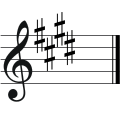C-sharp minor
C-sharp minor is a key of the tonal family minor, which is built on the root note C-sharp. The key of C-sharp minor is written in musical notation with four crosses (F-sharp, C-sharp, G-sharp, D-sharp). The corresponding scale and the fundamental chord of this key (the tonic c-sharp-e-g-sharp) are also designated by the term c-sharp minor.

![]()
![]()
![]()
![]()
![]()
![]()
![]()
![]()
![]()
![]()
![]()
![]()
![]()
![]()
![]()
Key classification
| Keys and their accidentals | |||||||||||||||
| Portent: | 7 ♭ | 6 ♭ | 5 ♭ | 4 ♭ | 3 ♭ | 2 ♭ | 1 ♭ | 0 ♭/♯ | 1 ♯ | 2 ♯ | 3 ♯ | 4 ♯ | 5 ♯ | 6 ♯ | 7 ♯ |
| Major keys: | Ces | Ges | Des | As | It | B | F | C | G | D | A | E | H | F# | C sharp |
| Minor keys: | as | it | b | f | c | g | d | a | e | h | F# | cis | gis | dis | ais |
Questions and Answers
Q: What is C-sharp minor?
A: C-sharp minor is a minor scale based on C-sharp.
Q: What is the key signature of C-sharp minor?
A: The key signature of C-sharp minor has four sharps.
Q: What is the relative major of C-sharp minor?
A: The relative major of C-sharp minor is E major.
Q: What is the parallel major of C-sharp minor?
A: The parallel major of C-sharp minor is C-sharp major.
Q: Can C-sharp minor be played on a piano?
A: Yes, C-sharp minor can be played on a piano by playing all the black keys except for B flat.
Q: What is the difference between a relative major and a parallel major?
A: A relative major is the major key that shares the same key signature as its relative minor, whereas a parallel major is the major key that has the same tonic as its parallel minor.
Q: In what type of music is C-sharp minor commonly used?
A: C-sharp minor is commonly used in classical and jazz music, as well as some rock and metal music.
Search within the encyclopedia














